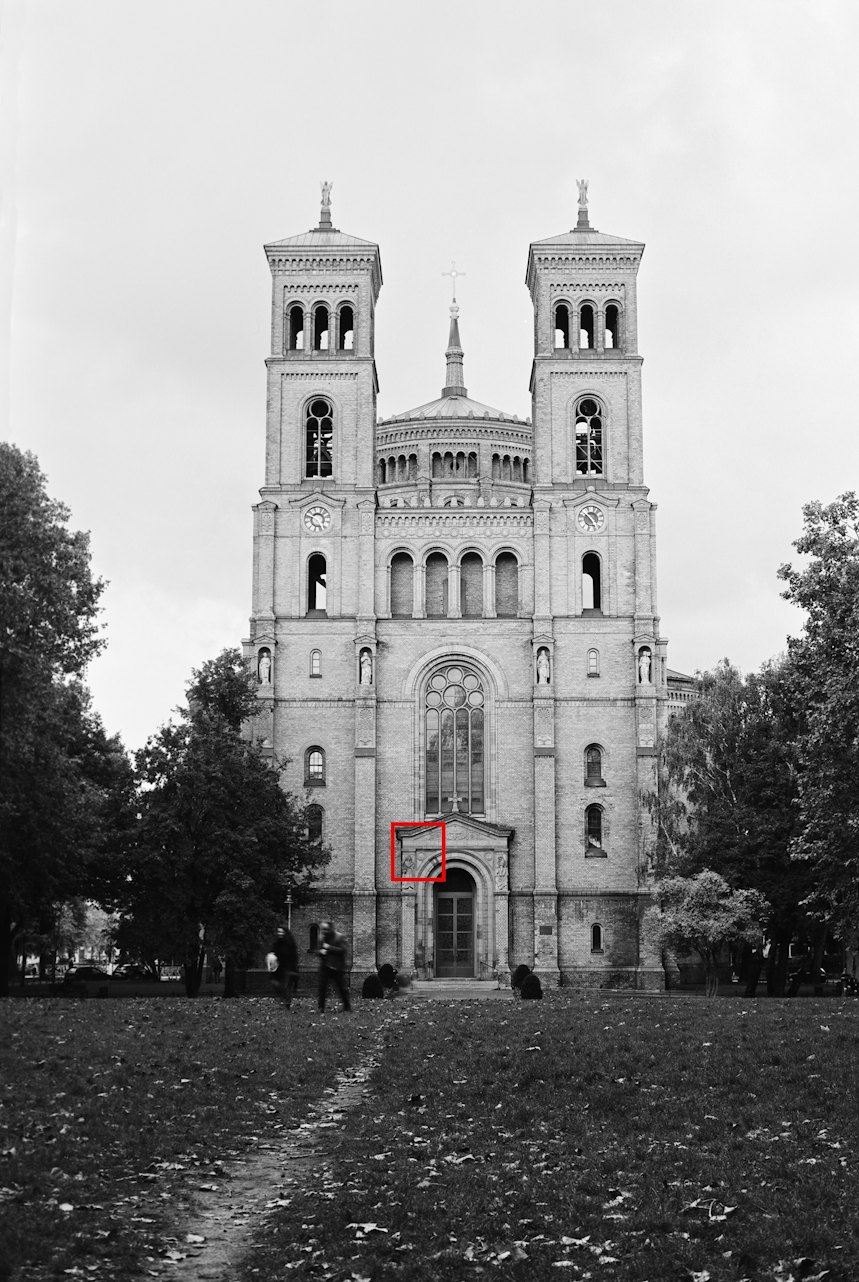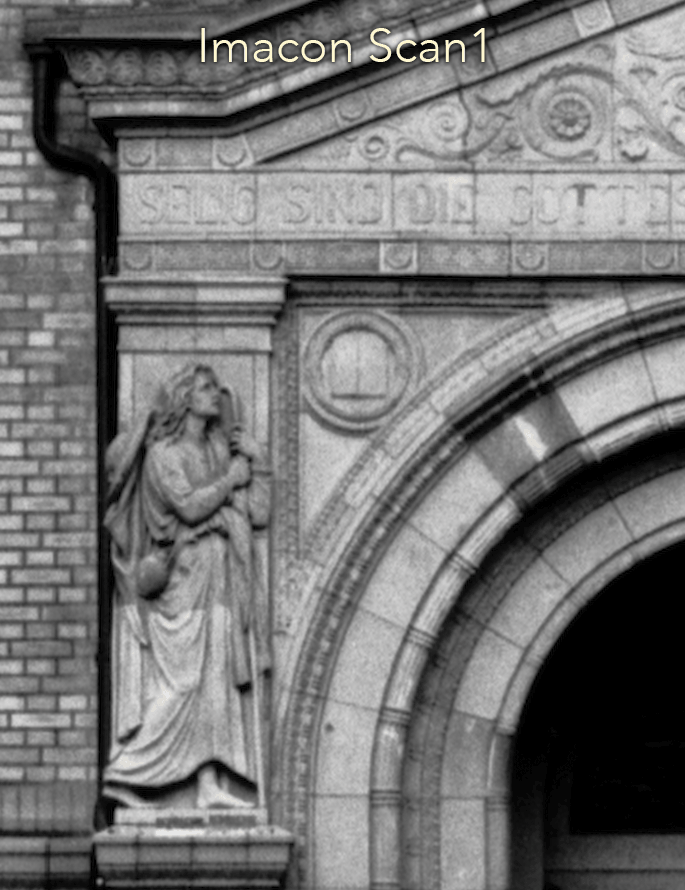
Comparison dokko / Imacon
Below a comparison of a detail of a 35mm film scanned once with the dokko scanner and with an Imacon (which is the most common scanner currently in use) at various resolutions. The red area markes the enlarged detail.

- the 3150ppi sample might look sharper then the 4000ppi sample on small screens because it's more pixelated.
- the 6300ppi sample has about the same detail as the 8000ppi sample, this is due to the lens in the Imacon scanner being unable to resolve more than around 5500ppi.
Other Scan Systems
Some background information to the scanning methods commonly used by other scan services:
Imacon / Hasselblad
The Imacon 848 and 949 scanners (and the almost identical successor models Hasselblad X1 and X5) were considered the benchmark among film scanners when they were introduced in 2001. As a comparison, at that time Apple was still selling its egg shaped G3 iMacs with CRT screens and Nikon just released their top-end digital camera D1x with 5.3 Megapixel. Since then, digital technology has made huge advances, allowing for much higher image quality. Unfortunately, it has not been financially worthwhile for the established scanner manufacturers to develop new film scanners, so nearly every scan service still uses 20 year old technology.
As impressive as the devices were at the time, the Imacon scanners have several shortcomings that were massively improved on the dokko scanner:
-
The Imacon/Hasselblad scanners capture the film line by line using a stepper motor and reassemble them by software. This results in significant distortions in the image due to inaccuracies in the transport system. The dokko scanner is built with a high-resolution area sensor, and by design is immune to this problem.
To visualise the issue, below a detail of the same film scanned twice in an Imacon 848 with identical settings: -
In order to keep costs down and simplify handling, the Imacon / Hasselblad scanners use the same lens for all film formats. Due to the different magnification factors, compromises had to be made in the optical performance of this lens, and the scanner falls short of its maximum, advertised resolution.
The dokko scanner employs different lenses, each specially optimised for a single film format, which enables it to achieve a significantly higher true optical resolution. -
Imacon advertised its scanners as virtual drum scanners, which simply meant a curved elastic film holder. The idea was that the curvature guarantees optimal sharpness over the entire image, but in practice there are often sharpness problems in the edge areas due to uneven bending of the film holder.
-
Imacon tried to compensate for the weaknesses in their lens and its holders by stopping down the scanner lens. This in turn leads to a loss of sharpness due to diffraction. In order to hide for this, the Imacon scanners apply significant digital sharpening filters that cannot be completely deactivated. The resulting scans appear over-sharpened, and the grain structure shows digital artefacts.
The dokko RAW scans are never digitally resharpened, and the production files get optimised for your intended use. -
With Imacon / Hasselblad scans, images are usually cropped at the borders by the image mask holding the film. The dokko scanner can capture the entire exposed frame, and can also scan films including the edge or even perforation area.

Drum scanners
In the 1970s, drum scanners were marvels of modern technology and the first machines that could deliver good scan quality. They were considered unsurpassable until the turn of the millennium.
However, similar to Imacon, no new models have been developed for over 20 years, so the machines that are currently in use are all based on technology that is decades old and severely outdated.
Drum scanners are still advertised as giving the best dynamic range and noise performance, but the reality is that modern digital sensors and signal processing achieve significantly higher image quality than electronics designed 20 years ago.
Some Drum scanners claim resulution up to 12000ppi, but the true optical resolution tops out around 5000-6000ppi. They can still produce good results with larger film formats, where scan resolution doesn't have to be very high. On medium and small format film it becomes obvious, that their resolution is much lower than the advertised values. Drum scanners also have problems with getting accurate colors out of color negative film.
Their working principle requires the film to be wet-mounted, which means the originals have to be immersed in an oil or solvent liquid solution and glued into a drum using adhesive tape. This puts wear and tear on the original, accumulating dirt and scratches. There's also the risk of the film coming loose and getting damaged in a drum rotating at speeds of 2000rpm.
The dokko system was designed to work without any liquids, adhesive tape or rotating drum in order to keep the original in pristine condition and minimise the risk of film damage.
As mentioned, all the drum scanners still in use today were developed over 25, some even 35 years ago. Below an overview of some common models, including the year of their introduction:
- Heidelberg Chromagraph DC 3000 (1990)
(check their brochure and promotion video) for a smile - Heidelberg Tango (1998)
- ICG 370HS (1999)
- Howtek HiResolve 8000 (1999)
- Dainippon Screen SG-8060P Mark II (2000)
- Heidelberg Primescan (2000)
Flatbed Scanners
High-end flatbed scanners can deliver very good results with large-format film originals, but with smaller formats their resolution is limited due to the optical system. Although they often advertise resolutions up to 6000ppi, their real optical resolution is about 2400ppi for the best prosumer levels and about 3000-4000ppi on the best high-end scanners. These are all machines from the turn of the century which means they are over twenty years old. Like drum scanners, they suffer from outdated sensors and electronics that are much noisier than modern digital components.
Widely used high-end models:
- Heidelberg Topaz (1997)
- Creo/Scitex EverSmart Pro (2001)
- Screen Cezanne Elite (2001)
- Creo/Kodak iQsmart 3 (2003)
- Creo/Kodak Eversmart Supreme (2005)
Frontier / Noritsu Minilab Scanner
Fuji Frontier and Noritsu scanners were developed to make fast, inexpensive preview scans and prints in minilab systems. They are commonly used to get an overview of all the images in a film.
These machines are also 20 years old and were tuned for speed and ease of use. The resulting images are unfortunately of rather poor quality, showing significant digital block artefacts and a restricted color palette. They are therefore only of limited use for further production and are no suitable digital backup for archiving.